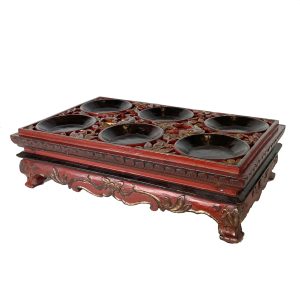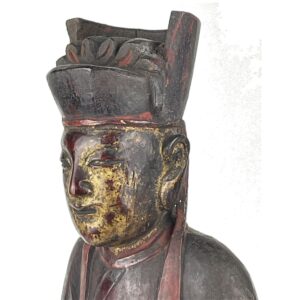-
Sale!


$425.00 Original price was: $425.00.$250.00Current price is: $250.00.
Ht: 8.25″ W: 3″ D: 2.125″ | FREE SHIPPING IN CONTINENTAL US!
Dressed in a red robe with a high neck collar, extremely wide sleeves extending below the knees and a belt around his waist, this ancestor figure portrayed as a civilian official standing on a rectangular base with hands together wearing a long civil official’s robe that extends to his shoes but has no rank badge indicated.
-
Sale!

$475.00 Original price was: $475.00.$325.00Current price is: $325.00.
H: 5.625″ W: 27.875″ D: 9.75″ | FOR SHIPPING INFORMATION CONTACT US AT 213-568-3030 OR EMAIL [email protected]
This exceptionally crafted and beautiful footed confection mould was most probably a marriage gift from a wealthy family to the newlyweds as seen its symbolisms. It is elaborated and ornately decorated in vibrant reds and gilt with auspicious symbols for fidelity, fertility and happiness with lotuses and pods filled with seeds, bats, paired fish and intertwined vines representing a life pair, having sons, and other marriage wishes.
-
Sale!


$345.00 Original price was: $345.00.$285.00Current price is: $285.00.
H: 6″ W: 2.5″ D: 4″ | CALL 213-568-3030 OR EMAIL [email protected] FOR SHIPPING.
This small fearsome carving is the Taoist Thunder God who provides protection from injustices and punishes earthly beings and wicked spirits who harm humans. His drum and mallet produce thunder and his chisel to punish evildoers. He has a bird’s beak and claws and dragon’s wings and rides a mythical hou who protects it masters from evil and bad fortune. This carving and the Guanti God of Justice on a Hou (16325) are from a detailed bed frame with many protective deities guarding the home.
-
Sale!


$365.00 Original price was: $365.00.$295.00Current price is: $295.00.
H: 2.625” W: 6.125” D: 4” | FREE SHIPPING WITHIN CONTINENTAL U.S.!
This delicate antique Yixing teapot is unusually shaped with a loop handle, short spout, flaring rim, small flat cover and small loops below its rim that indicate it may have been used to suspend oil or soy sauce rather than serve tea. Its charm is enhanced by its free hand-painted colored enamels with 6 circular panels containing fanciful and bright floral and leaf decorations. Chinese tea connoisseurs consider Yixing teapots the best vessel for brewing tea as it is naturally porous to absorb oils released during brewing and improves tea’s flavor with continual use. Recommended for display only, it pairs well with 1152A-PAR Enameled Yixing Stoneware Teapot.
-
Sale!


$595.00 Original price was: $595.00.$375.00Current price is: $375.00.
H: 5.625″ W: 27.875″ D: 9.75″ | CALL 213-568-3030 OR EMAIL [email protected] FOR SHIPPING
The low profile and fine lacquered finish of this charming antique wood chest add warmth and a touch of antique fine craftsmanship to any setting. The two intricately carved drawers for storage lend it to a multitude of uses. Carved auspicious symbols to bring the Five Blessings or Happinesses include peonies and vines, butterflies, plum blossom and a Japanese lily. The sides have inset panel with florals and the bottom has a decorative apron with a beautiful fretwork vine design. Its warm patina extends to the detailed brass butterfly handles.
-


$985.00
H: 15″ W: 6.5″ D: 5.5″ | EMAIL [email protected] OR CALL 213-568-3030 FOR SHIPPING COST
This excellently carved civilian official with gilt highlights was commissioned by a family to place on a home altar for veneration and to impress those who viewed it. The imposing ancestor figure grasps his belt of office to show his pride in passing examinations to become a civil official, which leads to a life of rank and prosperity for him and his family. Statues like this are an affirmation of persistence, success, status and power and they honor those who display these characteristics.
-
Sale!


$450.00 Original price was: $450.00.$395.00Current price is: $395.00.
Ht: 9″ W: 5″ D: 3.5″ | FREE SHIPPING WITHIN CONTINENTAL U.S.!
During the Ming and Qing dynasties small images of Taoist officials and priests were often shown holding a cup of the elixir of life to place on home altars along with ancestor figures, house gods and other religious images to bring blessings (fu) to the household. By commissioning figures like this artful carving, families honored their ancestors and met their filial piety duties. Mounted on an acrylic stand.
-


$375.00
H: 8.25″ W: 5.5″ D: 4″ | FREE SHIPPING WITHIN CONTINENTAL U.S.!
Guandi, the God of War and Justice and Protector of China and its citizens was a Chinese model of loyalty, virtue and morality and was depicted in Temples and home shrines throughout China. This antique figurine was probably part of a larger carving. He wears military maille, black gloves with a carved taotie which is a warning against gluttony and is covered in gold as a sign of power. The open back confirms it was consecrated by a Taoist priest. Mounted on a frosted acrylic stand.
-


$135.00
H: 8” W: 8” D: 3.75” | FREE SHIPPING IN CONTINENTAL US!
This charming white porcelain Siamese cat teapot has a raised paw for pouring tea, a removable head for adding water , and a long sinuous tail handle. The beautifully hand-painted design is whimsical and colorful with a thick dark red collar ribbon, a matching ornamental bow, and a ball under its left paw. Black, orange, red and blue accents define the cat’s face, ears, head, paws and the ball.
-


$240.00
Ht: 9.75″ W: 3.5″ D: 2.5″ | FREE SHIPPING WITHIN CONTINENTAL U.S. !
This Chinese Republic Period delicate porcelain figurine holds a rose at her heart in her right snow white hand, her left arm covered by her shawl resting on a waist-high decorative vase with an opening to hold incense (joss) sticks. Her shawl drapes over her shoulders and lower garment with floral motifs extending to the beaded belt at her waist. The sweet facial expression with slightly smiling bowed lips is framed by her piled hair looped in a chignon over each ear. Given her luxurious garments and accessories, she is an aristocratic woman. The rose was often used on porcelains during this period, representing eternal spring.
End of content
End of content



















